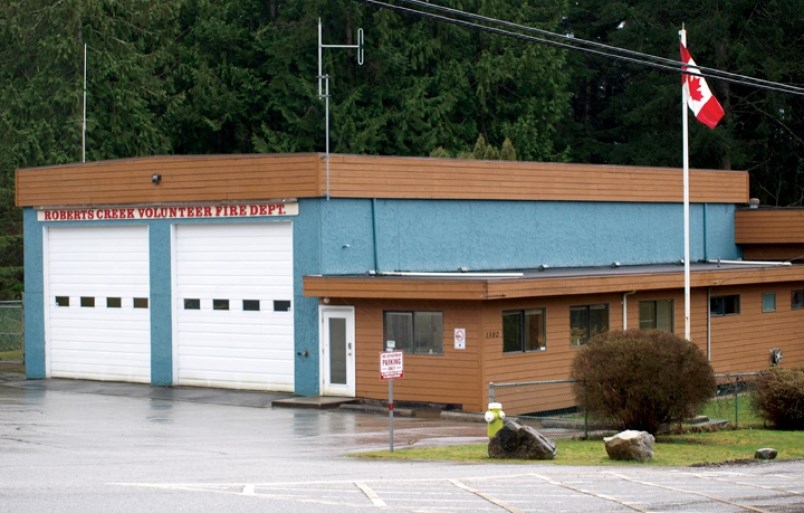Halfmoon Bay and Roberts Creek fire chief positions will change from volunteer to paid positions, but the bigger question of whether the district will hire someone to coordinate emergency services on the Coast remains an open one.
Directors voted on those recommendations after reviewing the 2018 strategic plan for the Sunshine Coast’s fire departments as well as the emergency program at a Jan. 10 Sunshine Coast Regional District (SCRD) planning committee meeting.
Dozens of recommendations came out of the reports by Dave Mitchell & Associates, which took a year to complete, including creating a full-time “manager of protective services” position that would manage and implement the emergency program as well as oversee training and operations for the SCRD’s four fire departments, located in Gibsons, Roberts Creek, Halfmoon Bay and Egmont.
Directors voted to defer the decision following remarks by Sechelt Mayor Darnelda Siegers, Gibsons Mayor Bill Beamish and rural area E and F directors, all of whom agreed it was “premature” to decide whether to create the role, in part because neither Gibsons nor Sechelt councils have had a chance to review the position or reports.
“I don’t have direction from my council and I don’t see that we actually have the information required to fulfill the position as it’s laid out here,” Siegers said.
She said she was concerned that even though the District of Sechelt would be funding the position along with Gibsons and the rural areas, Sechelt did not have the option to vote.
Beamish said he was “uncomfortable” making a decision without direction from Gibsons council considering the position presents “a fundamental change in direction relative to the emergency program.”
The position of emergency coordinator is being filled temporarily by Gibsons fire chief Rob Michael. Bill Elsner, who occupied the full-time role, resigned in August.
Rather than pay a part-time contract position to manage the fire departments’ special projects, the consultants recommended creating a “permanent fire service coordinator role,” which would also incorporate the emergency program coordinator responsibilities – a typical role for regional districts with several fire services, according to the report.
The emergency program was one of the province’s first, and coordinates all local governments, first responders and volunteer emergency organizations on the Coast.
The new role is estimated to cost $28,000 more than the emergency coordinator role and would be funded through taxation and the Sunshine Coast Emergency Program service.
Whoever assumes that role would be responsible for implementing the rest of the fire department strategic plan recommendations. That responsibility will fall on the shoulders of CAO Janette Loveys until a decision is made.
Directors will get another chance to discuss the position of the emergency coordinator, however, because it, along with other recommendations stemming from the emergency program review report, will be brought before the board at the first round of budget talks in February.
As for the Roberts Creek and Halfmoon Bay fire chiefs, both chiefs receive an annual honorarium of $6,000 and $2,000 respectively. Currently, the fire halls hire administrative assistants but the report recommends dropping those roles after the employees retire and using the funds to pay for full-time fire chiefs. Directors voted unanimously to move ahead with the recommendation.
When West Howe Sound director Mark Hiltz asked the consultants for a “couple sentences” he could use to explain why taxpayers should pay for two more positions, consultant Dave Mitchell responded, “Your departments are doing more of everything, they’re doing more complex calls,” and they also have more statutory responsibilities.
Call volume was a focus of the report. It has climbed to 575 in 2017 from 324 in 2009 and calls are expected to double by 2028. The bulk of them come from illegal burning, motor vehicle incidents (MVIs) and alarms, but fire calls are also on the rise. Calls have nearly tripled in Roberts Creek where they have become “particularly expert” at MVIs.
Area D director Andreas Tize, a former volunteer with the Roberts Creek Fire Department, asked repeatedly about volunteer consultation and whether they would “have a say” in the selection of a new chief. “This is a big change in governance for these volunteers. I just want to make sure they are happy,” he said. Staff confirmed a volunteer will be included on the selection panel.
The emergency plan review will be referred to affected organizations including the District of Sechelt, Town of Gibsons, Sechelt Indian Government District, School District No. 46 and the Gibsons and District Fire Commission, and volunteer groups will also be consulted.
Also included in the reports were recommendations to update bylaws to make them more consistent and to address certain statutory changes. A new Fire Safety Act is also on its way, which the SCRD will need to address.
Also needing updates are the mutual-aid agreements that allow municipalities, governments and organizations on the Coast to collaborate during emergencies.
Mitchell commended the fire departments and SCRD administration as “absolutely exemplary” when presenting the reports to the board. Fire chiefs from the affected fire halls were in attendance.



